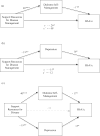Glycemic control among Latinos with type 2 diabetes: the role of social-environmental support resources
- PMID: 21553968
- PMCID: PMC3384508
- DOI: 10.1037/a0022850
Glycemic control among Latinos with type 2 diabetes: the role of social-environmental support resources
Abstract
Objective: Although active diabetes self-management is required to achieve glycemic control, adherence is poor among ethnic minorities, especially Latinos. Research shows that individuals who report greater social-environmental support resources for disease management manage their diabetes more effectively than those with fewer support resources.
Methods: Path analysis was conducted to investigate the value of a multiple-mediator model in explaining how support resources for disease management influence hemoglobin A1c (HbA1c) levels in a sample of 208 Latinos with Type 2 diabetes recruited from low-income serving community clinics in San Diego County. We hypothesized that the relationship between support resources for disease-management and HbA1c would be mediated by diabetes self-management and/or depression.
Results: Participants who perceived greater support resources for disease-management reported better diabetes self-management (β = .40, p < .001) and less depression (β = -.19, p < .01). In turn, better diabetes self-management and less depression were associated with tighter glycemic control (HbA1c; β = -.17, p < .05 and β = .15, p < .05, respectively). Once the indirect effects via diabetes self-management (95% CI [-.25; -.03]) and depression (95% CI [-.14; -.01]) were statistically controlled, the direct pathway from support resources to HbA1c was markedly reduced (p = .57).
Conclusions: These findings demonstrate the important connection that support resources for disease management can have with diabetes self-management, emotional well-being, and glycemic control among Latinos. Thus, programs targeting diabetes self-management and glycemic control in this population should consider culturally relevant, multilevel influences on health outcomes.
(c) 2011 APA, all rights reserved.
Figures


Similar articles
-
An ecological perspective on diabetes self-care support, self-management behaviors, and hemoglobin A1C among Latinos.Diabetes Educ. 2015 Apr;41(2):214-23. doi: 10.1177/0145721715569078. Epub 2015 Feb 5. Diabetes Educ. 2015. PMID: 25656696 Clinical Trial.
-
Who benefits from diabetes self-management interventions? The influence of depression in the Latinos en Control trial.Ann Behav Med. 2014 Oct;48(2):256-64. doi: 10.1007/s12160-014-9606-y. Ann Behav Med. 2014. PMID: 24664615 Clinical Trial.
-
Validation of theoretical pathway between discrimination, diabetes self-care and glycemic control.J Diabetes Complications. 2016 Jul;30(5):858-63. doi: 10.1016/j.jdiacomp.2016.03.014. Epub 2016 Mar 17. J Diabetes Complications. 2016. PMID: 27068266 Free PMC article.
-
Effect of diabetes self-management education on glycemic control in Latino adults with type 2 diabetes: A systematic review and meta-analysis.Patient Educ Couns. 2020 Feb;103(2):266-275. doi: 10.1016/j.pec.2019.09.009. Epub 2019 Sep 9. Patient Educ Couns. 2020. PMID: 31542186 Free PMC article.
-
The role of depression and diabetes distress in glycemic control: A meta-analysis.Diabetes Res Clin Pract. 2025 Mar;221:112014. doi: 10.1016/j.diabres.2025.112014. Epub 2025 Jan 30. Diabetes Res Clin Pract. 2025. PMID: 39892818 Review.
Cited by
-
My Bridge (Mi Puente), a care transitions intervention for Hispanics/Latinos with multimorbidity and behavioral health concerns: protocol for a randomized controlled trial.Trials. 2020 Feb 12;21(1):174. doi: 10.1186/s13063-019-3722-8. Trials. 2020. PMID: 32051005 Free PMC article.
-
Effects of a Family-based Diabetes Intervention on Behavioral and Biological Outcomes for Mexican American Adults.Diabetes Educ. 2017 Jun;43(3):272-285. doi: 10.1177/0145721717706031. Epub 2017 Apr 27. Diabetes Educ. 2017. PMID: 28447545 Free PMC article. Clinical Trial.
-
The relationship between depressive symptoms and medication nonadherence in type 2 diabetes: the role of social support.Gen Hosp Psychiatry. 2012 May-Jun;34(3):249-53. doi: 10.1016/j.genhosppsych.2012.01.015. Epub 2012 Mar 7. Gen Hosp Psychiatry. 2012. PMID: 22401705 Free PMC article.
-
Dulce Digital-Me: protocol for a randomized controlled trial of an adaptive mHealth intervention for underserved Hispanics with diabetes.Trials. 2022 Jan 28;23(1):80. doi: 10.1186/s13063-021-05899-x. Trials. 2022. PMID: 35090520 Free PMC article.
-
Impact of social determinants of health on outcomes for type 2 diabetes: a systematic review.Endocrine. 2014 Sep;47(1):29-48. doi: 10.1007/s12020-014-0195-0. Epub 2014 Feb 15. Endocrine. 2014. PMID: 24532079 Free PMC article.
References
-
- American Psychological Association. Diagnostic and Statistical Manual of Mental Disorders. 4. American Psychiatric Association; Washington, DC: 1994.
-
- American Diabetes Association. Standards of medical care for patients with diabetes mellitus. Diabetes Care. 2002;25(1):213–229. - PubMed
-
- Anders RL, Olson T, Wiebe J, Bean NH, DiGregorio R, Guillermina M, et al. Diabetes prevalence and treatment adherence in residents living in a colonia located on the West Texas, USA/Mexico border. Nursing and Health Sciences. 2008;10:195–202. - PubMed
-
- Anderson RJ, Freedland KE, Clouse RE, Lustman PJ. The prevalence of comorbid depression in adults with diabetes: a meta-analysis. Diabetes Care. 2001;24:1069–1078. - PubMed

